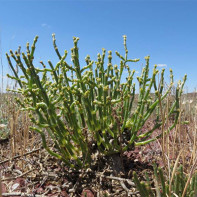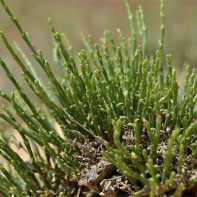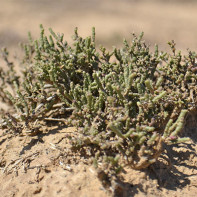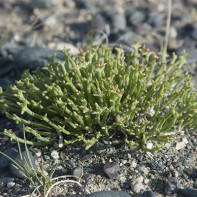Anabasis: medicinal properties and contraindications
Anabasis (bramble) is a plant from the haze family. Plants have the appearance of a shrub or grass with poorly developed foliage. Leafless anabasis has spread in medicine. It is distinguished by its antiseptic properties and ability to reduce nicotine addiction. However, this plant is very toxic, so you can take it at your own peril and risk after consulting a doctor.
- Chemical composition
- How it looks and where it grows
- Kinds
- Collection and storage
- The healing properties of anabasis
- Anabasis in folk medicine
- Pest solution
- Decoction against demodicosis
- Alcohol tincture for the skin
- A decoction of parasites
- Tick powder
- Types of healing compounds
- Tincture
- Decoction
- Contraindications
Chemical composition
Each part of the plant contains alkaloids. Most of them were found in annual green shoots of a plant. In the flowers and fruits of the plant, there are fewer of them, and in the roots there are only their traces. Therefore, for medicinal purposes use the terrestrial parts of the plant. Plants contain the following alkaloids:
- anabazine;
- afillin;
- affillidine;
- oxyafillin;
- hydroxyaphyllidine.
The main alkaloid is anabazine. It accounts for approximately 55-60% of the total amount of substances. It is a colorless liquid that dissolves easily in water. When interacting with organic solvents, it produces organic and mineral acids. In the process of anabazine oxidation, nicotinic acid is formed. It is in all respects, including the composition and effect on the body, similar to nicotine. But this alkaloid makes the plant poisonous.
In addition to alkaloids, anabasis contains proteins, fats, fiber and starch. It also found pectin, ash, sodium, potassium and some other rare substances.
How it looks and where it grows
The plant looks like a small spherical shrub, with a height of not more than 70–80 cm, and its diameter can reach 140 cm. It has a powerful root system, the length of the main root can reach up to 20 m, which allows it to receive moisture from groundwater. The plant has numerous stems that begin to branch at the base. The lower part of the stems is lignified. Young green shoots grow from them, they have a cylindrical shape and are colored green. The leaves of the anabasis are poorly developed, they are almost invisible.
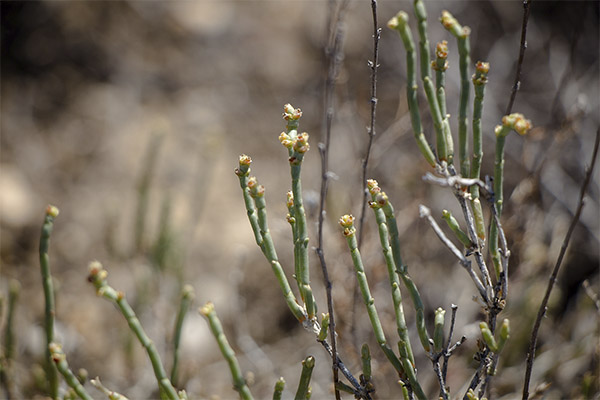
Anabasis flowers are small, form dense spike-shaped inflorescences. At the top of the plant are the fruits. They have a red-orange color and a rounded shape, flattened on the sides.
Anabasis propagates with seeds, the flowering period falls at the end of summer or beginning of autumn. Ripening of flowers occurs in mid-autumn. Usually, an anabasis planted artificially does not begin to bloom in the first year of growth.
This species is widespread among the plains of Kazakhstan, in East Asia and in Azerbaijan. Also found in southeastern regions of Russia. Anabasis prefers to grow on the plains and foothills, most often on clay soil. It can also be found on the slopes of mountain peaks, at an altitude of up to 350-400 m. Lonely shrubs can be found in thickets of weeds, large groups are found in river and lake valleys. In Central Asia, the plant is artificially grown on an industrial scale.
Anabasis is adapted to grow in a desert zone with intense heat. It grows well at temperatures up to 45 degrees and in the absence of precipitation for several months. It's all about a powerful root system, which allows you to economically consume moisture and reach deep groundwater. Finding an anabasis in the desert in summer is very simple - it is one of the few plants that remains green.
Kinds
There are several main varieties of this plant. All of them mainly grow in Central Asia, but some species have adapted to life in some regions of Siberia.
- Anabasis is salt marsh. This is a small plant with stems. In height rarely exceeds 25-30 cm.The branches are woody, annually annual shoots appear on them, which die off in late autumn. The lower leaves are well developed, but their size does not exceed 5 mm. The middle ones are developed a little worse, the upper ones are underdeveloped. The flowers of this anabasis are small in size, collected in spike-shaped inflorescences. Fruits grow in the upper part of the plant; they have a rounded, slightly oblong shape. They contain a lot of bright red liquid. For the most part, this species is common in Central Asia, but it can be found in the Caucasus, the western part of the Russian Federation and in western Siberia.
- Syr Darya Anabasis. Perennial plant with a long root, from which branched shoots grow up to 30 cm long. The leaves are round, oblong, in length do not exceed 5 mm. Flowers are in the axils of the leaves. There are no fruits. It is found only in Central Asia.
- Anabasis is short-leaved. Shrub, not more than 15 cm in height. The shoots are branched, thick, have a cylindrical shape. The plant itself is bare. A few leaves are oblong, slightly convex below, fleshy. Their length does not exceed 5 mm. Flowers are located in the axils of the leaves. The fruits of the plant are ovoid, dry.
- Anabasis Cretaceous. A small plant not exceeding 15 cm in height. It has numerous stems, which are located very densely to each other. Their diameter does not exceed 3 mm. The leaves are egg-shaped, with flowers in their sinuses. The fruit can be purple or orange, has an ovoid shape. This species is widespread in Europe, Central Asia and even Siberia. Also found in southern Russia. In some regions, the plant is listed in the Red Book.
Collection and storage
Raw materials should be harvested during the period when it contains the highest concentration of anabasis and other components. Usually this period falls in the summer. Raw materials need to be harvested in sunny weather, away from highways and factories. Before collecting the plants, it is advisable to protect the hands with gloves, since the substances contained can cause poisoning even through the skin. Using a sharp tool, you need to cut off the top of the plant up to 25 cm long. In order not to lead to the destruction of the species, it is important to adhere to certain rules:
- Do not trim the bushes completely. It is necessary to leave at least 1/3 of the shoots.
- Take a break every 3-4 years. This will allow the plant to renew.
First, all cut shoots need to be stacked. You can leave them right on the field. Next, prepare the plant before final drying - cut into small pieces, a length of not more than 3 cm and a thickness of not more than 4-5 mm. This can be done using a silage cutter. Anabasis should be dried in a well-ventilated area. An attic will be a great option in the summer. In good weather, you can spread the raw materials on the street, in the shade of a tree. It is necessary to choose a place so that direct sunlight does not fall there. You can also use special dryers to dry the raw materials.
Dry raw materials are suitable for use as a medicine for no more than 2 years. It is also important to follow all storage rules for poisonous plants. It is advisable to store it separately from other plants and food products. You can store it in a fabric bag or in a glass jar, but it is advisable to sign the date of collection in order to determine the exact date.
Harvesting plants on an industrial scale
This plant has been harvested on a large scale since the time of the USSR. After the war, demand for it jumped, and the demand reached 16 thousand tons. Now this plant has also remained in high demand.
Currently, harvesting takes place in Kazakhstan in several areas. Long ago, special work was carried out to detect thickets of anabasis. Now they are known, but it is also grown artificially. On the plains, anabasis is found in the form of single shrubs. Large thickets were found in river valleys, although they are not numerous. In addition, they are not suitable for industrial processing, since they contain little of the main alkaloid - anabazine.
Also, over time, it was discovered that plant stocks were gradually decreasing, so collection rules were introduced.It was experimentally found that to restore anabasis, it is necessary to take a break in the collection of raw materials every 3-4 years. The duration of the break is one year. Some areas are not enough of such a break, and it has to be increased.
In second place in the collection of anabasis is Turkmenistan, or rather, the northern part of the country. According to some reports, more than 30 hectares of this plant were found, but over time, the area decreased. But on an industrial scale, blanks were not made here, which allowed us to preserve reserves for the future.
About 3 hectares of anabasis were discovered in Azerbaijan. Raw materials were also not made from it due to low profitability due to transportation.
On an industrial scale, the plant is harvested using special equipment. Cut off the upper parts of the shoots so as not to harm the plant. When cleaning appliances leave a small strip untouched. The cut shoots are stacked in small piles, after drying, they are carefully crushed. After this, the raw materials are sieved so as not to miss impurities. Sifting also eliminates stubble shoots that are not suitable for use.
Harvesting plants is made during the summer and autumn, before the onset of frost. From one bush you can get up to 2.4 kg of shoots. In the worst case, 600–800 g. In Kazakhstan, about 1000 kg of shoots can be harvested per hectare. In rarer thickets sometimes it is not possible to collect even 50 kg.
Throughout the flowering period in the anabasis, the amount of anabazine changes. For example, in summer the highest concentration is observed, by autumn its content decreases. But at the same time, the green mass increases, so at any time of the year, approximately the same amount of raw material is collected.
The healing properties of anabasis
Anabasis was widely used in both traditional and traditional medicine. The plant itself is not a component of drugs, but many drugs are synthesized from its alkaloids (most often anabazine).
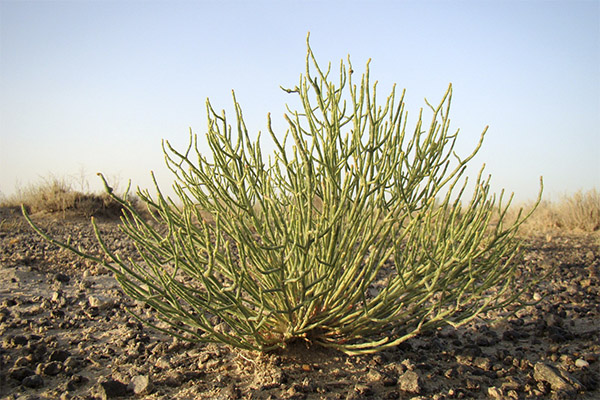
The main active ingredient is the anabazine alkaloid. It has a stimulating effect on the nervous system, but in large quantities can lead to paralysis. Afilin, which is part of the composition, is distinguished by its anesthetic effect.
Of the components of the plant, a preparation is prepared that allows you to successfully fight pests in the garden. It has the property of poison and is used to spray plantings for the purpose of disinfection.
In folk medicine, it is used externally. Ingestion can be dangerous. Anabasis-based drugs treat wounds in certain diseases. The plant has an anti-mite, antimicrobial and bactericidal effect. It's all about his ability to penetrate the skin. He can even get those parasites that are deep in the skin, and other drugs can not affect them. But even with external use, this plant must be handled carefully.
In addition, anabasis can eliminate the symptoms caused by tick infection. It contains antioxidants and antifungal components. However, this is not a miracle remedy and can only act as an addition to the main therapy, and not completely replace it.
Anabasis can also be an assistant for people who quit smoking. Anabazine hydrochloride is synthesized from this plant, which is sold in the form of tablets or chewing gum. He is able to fight off the craving for smoking, as well as alleviate the condition after giving up this bad habit.
Anabasis in folk medicine
Due to the high toxicity of the plant, its use in folk medicine is very limited. For health problems, use only tincture or decoction. Also, it is used to make powder for wounds, but it will not work on its own.In addition, it is used to control pests in vegetable gardens.
Pest solution
It will take 800 g of shoots that were collected before flowering, 41 l of water and 50 g of laundry soap. Anabasis shoots need fresh. They should be dried a little, crushed, then filled with water and left to infuse for a day, gradually stirring. Then dilute an additional 10 liters of water and grate the soap. Then mix thoroughly, after which the product is ready to use. They can process vegetables. This tool copes with leaf-eating caterpillars, various fleas and some flower beetles.
Decoction against demodicosis
To prepare the medicine, anabasis leaves are required. When collecting them, it should be borne in mind that in summer the concentration of anabazine in them is the highest. In the fall, it drops slightly, but still remains in dangerous quantities. To prepare a decoction, you need to pour the leaves of anabasis with warm water, then bring to a boil, and leave on the stove for 10-15 minutes. Wipe affected skin no more than 3 times a day. It is recommended to keep the product for no more than 2 hours, then rinse the skin thoroughly. You can also use a decoction for washing, in which case the course of treatment can last until complete recovery.
Alcohol tincture for the skin
Alcohol tincture is no less effective in demodicosis than decoction. Unlike tinctures on other herbs, it is prepared in just 4-6 days. However, vodka is not suitable for preparation, you need a solution of alcohol 70%. Mix the crushed anabasis with alcohol in a ratio of 1: 2. Then mix thoroughly, close the lid and put in a dark place. After 5 days, get the tincture and strain. It is impossible to store it in the same container where it was infused, so you need to find a new vessel, sign a container with tincture and store it out of the reach of children. Take tincture inside is strictly prohibited.
Apply tincture to the face with a cotton swab no more than 2 times a day. Improvements can be seen in a week or two. It is also important to apply tincture in small amounts to avoid burns from alcohol, and rinse it off the face after 60 minutes.
A decoction of parasites
It will take 800 g of dried grass and 5 l of water. Pour grass in 5 liters of water, then leave to leave in a dark place, cover with a lid. The next day, bring to a boil and boil for 30 minutes. Then strain and cool. Spray a decoction of the plant from a spider mite, apple moth or weevil.
Tick powder
It is prepared from the stems of a dried plant. To prepare the medicine, you need to grind the raw materials to a powder state and apply in small amounts to damaged skin areas. The powder also alleviates the symptoms of demodicosis. However, this is very dangerous, since anabazine can be absorbed through the blood, therefore, before using such a drug, it is better to consult a doctor to determine the dosage.
Types of healing compounds
Unlike other poisonous medicinal plants, the use of anabasis is limited. For example, even tea is made from lily of the valley. The fact is that the anabazine, which is part of this plant, is excessively toxic, a lethal dose is 2 or 3 drops. Therefore, only substances synthesized from this element are used internally. Anabasis infusion is also not prepared due to its low efficiency for external use. In this regard, tincture is more effective.

Tincture
Tincture is prepared for alcohol. Only external use is permitted. To prepare the tincture, you can use any part of the plant, but it is better to use leaves or flowers. First, thoroughly grind the raw materials, then pour strong alcohol and put in a dark place for 5-7 days. It is advisable to insist the medicine in a glass jar.Then strain it through a dense fabric, you can use gauze folded several times (after which it is recommended to throw it away).
Apply tincture in small quantities, it effectively copes with demodicosis, which is caused by ticks. Wipe sore spots in the morning and evening in small quantities.
Decoction
In Central Asia, a decoction of anabasis roots was used to treat tuberculosis. The fact is that the roots contain a minimal amount of alkaloids. First they need to be washed from the ground, crushed and pour boiling water, then put on fire and cook for another 30 minutes. However, this tool has been used for a long time, and there is no mention of the modern use of this medicine for the treatment of tuberculosis.
Contraindications
Due to the high toxicity of the plant has a number of contraindications. Anabazine is a very strong poison for the body. It can cause poisoning by penetrating the skin, so even when applying the plant externally, you need to remember the dosage. The lethal dose for a person is 3 drops of pure anabazine. Symptoms of mild poisoning are common: nausea, vomiting, increased salivation, rapid breathing and acceleration of the heart rhythm. In case of severe poisoning, convulsions, cold sweat and respiratory failure, as well as delirium, can occur. It is important to provide timely assistance. It is recommended to immediately wash the stomach. It is also advisable to stock up with drugs that cause vomiting, and in case of poisoning immediately use them. After this, you need to take activated carbon. In addition, a number of additional therapeutic procedures will be required, including various enemas (saline, laxatives and cleansing).
It is also forbidden to take it in any form to pregnant women, nursing mothers, with high blood pressure, poor blood coagulation and atherosclerosis.
Anabasis is an excellent remedy for some skin diseases and garden pests. However, do not forget about the high danger of the plant. This is the case when self-medication can be deadly.
«Important: all information on the site is provided exclusively in fact-finding purposes. Before applying any recommendations, consult with a profile specialist. Neither the editors nor the authors are liable for any possible harm caused materials. "


